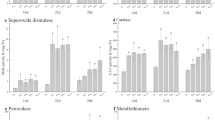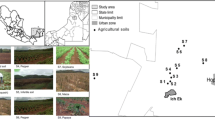Abstract
This study focused on the study of earthworm survival, growth, reproduction, enzyme activities, and protein contents to evaluate and predict the effects of different soil pH levels and determine the optimal risk assessment indicators for the effects. Survival rate, growth rate, and cocoon number as well as four enzyme (glutathione peroxidase (GSH-PX), superoxide dismutase (SOD), peroxidase (POD), and catalase (CAT)) activities and two proteins (total protein (TP) and metallothionein (MT)) contents in earthworms were determined to characterize the responses of earthworm activity to five soil pH levels. These biological datasets (survival, growth, and reproduction) were compared with biochemical indexes (GSH-PX, SOD, POD, CAT, TP, and MT), mainly using biphasic dose-response models. The results indicated that the soil pH value had significant inhibitory effects on the survival, growth, and reproduction of earthworms beginning with 3.0, 4.0, and 5.2, respectively. The dose-response models (J-shaped and inverted U-shaped curves) statistics indicated that the critical values (ECZEP) of the GSH-PX, SOD, POD, CAT, TP, and MT inhibited by soil acid stress were 3.46, 3.76, 3.35, 3.54, 3.50, and 3.96 (average 3.60), respectively. In the present study, the fitting curve analysis showed that the responses of the CAT activities and TP and MT contents in earthworm in response to soil pH have the behavior of hormesis.




Similar content being viewed by others
References
Beckon WN, Parkins C, Maximovich A, Beckon AV (2008) A general approach to modeling biphasic relationships. Environ Sci Technol 42:1308–1314
Bradford MM (1976) Rapid and sensitive method for quantitation of microgram quantities of protein utilizing principle of protein-dye binding. Anal Biochem 72(1/2):248–254
Brown TT, Koenig RT, Huggins DR, Harsh JB, Rossi RE (2008) Lime effects on soil acidity, crop yield, and aluminum chemistry in direct-seeded cropping systems. Soil Sci Soc Am J 72:634–640
Calabrese EJ (2001) Overcompensation stimulation: a mechanism for hormetic effects. Crit Rev Toxicol 31:425–470
Calabrese EJ, Baldwin LA (2003) Toxicology rethinks its central belief. Nature 421:691–692
Calabrese EJ, Blain R (2005) The occurrence of hormetic dose responses in the toxicological literature, the hormesis database: an overview. Toxicol Appl Pharmacol 202:289–301
Calabrese EJ (1999) Evidence that hormesis represents an “overcompensation” response to a disruption in homeostasis. Ecotoxicol Environ Saf 42:135–137
Chan KY, Mead JA (2003) Soil acidity limits colonisation by Aporrectodea trapezoides, an exotic earthworm. Pedobiologia 47:225–229
Chen X, Wang XR, Gu XY, Jiang Y, Ji R (2017) Oxidative stress responses and insights into the sensitivity of the earthworms Metaphire guillelmi and Eisenia fetida to soil cadmium. Sci Total Environ 574:300–306
Dedeke GA, Owagboriaye FO, Adebambo AO, Ademolu KO (2016) Earthworm metallothionein production as biomarker of heavy metal pollution in abattoir soil. Appl Soil Ecol 104:42–47
Edwards CA (2004) The importance of earthworms as key representatives of the soil fauna. In: Edwards CA (ed) Earthworm ecology. Boca Raton, Florida, pp 3–11
Edwards CA, Bohlen PJ (1996) Biology and ecology of earthworms, third edn. Chapman and Hall, London, pp 142–145
Ge H, Liu S, Zhu X, Liu H, Wang L (2011) Predicting hormetic effects of ionic liquid mixtures on luciferase activity using the concentration addition model. Environ Sci Technol 45:1623–1629
Guo JH, Liu XJ, Zhang Y, Shen JL, Han WX, Zhang WF, Christie P, Goulding KWT, Vitousek PM, Zhang FS (2010) Significant acidification in major Chinese croplands. Science 327:1008–1010
Hackenberger BK, Jarić-Perkušić D, Stepić S (2008) Effect of temephos on cholinesterase activity in the earthworm Eisenia fetida (Oligochaeta, Lumbricidae). Ecotoxicol Environ Saf 71:583–589
Hodson ME, Donner E (2013) Managing adverse soil chemical environments. Blackwell, Chichester, pp 195–237
Homan C, Beier C, Mccay T, Lawrence G (2016) Application of lime (CaCO3) to promote forest recovery from severe acidification increases potential for earthworm invasion. For Ecol Manag 368:39–44
Hu SQ, Zhang W, Li J, Lin KF, Ji R (2016) Antioxidant and gene expression responses of Eisenia fetida following repeated exposure to BDE209 and Pb in a soil-earthworm system. Sci Total Environ 556:163–168
Jia L, Liu ZL, Wei C, Ye Y, Yu S, He XY (2015) Hormesis effects induced by cadmium on growth and phototsynthetic performance in a hyperaccumulator, Lonicera japonica Thunb. J Plant Growth Regul 34:13–21
Kunito T, Isomura I, Sumi H, Park HD, Toda H, Otsuka S, Nagaoka K, Saeki K, Senoo K (2016) Aluminum and acidity suppress microbial activity and biomass in acidic forest soils. Soil Biol Biochem 97:23–30
Li YS, Sun J, Robin P, Cluzeau D, Qiu JP (2014) Responses of earthworm Eisenia andrei exposed to sublethal aluminium levels in an artificial soil substrate. Chem Ecol 7:611–621
Liu S, Zhou QX, Wang YY (2011) Ecotoxicological responses of the earthworm Eisenia fetida exposed to soil contaminated with HHCB. Chemosphere 83:1080–1086
Liu T, Wang XG, Chen D, Li YQ, Wang FL (2018) Growth, reproduction and biochemical toxicity of chlorantraniliprole in soil on earthworms (Eisenia fetida). Ecotoxicol Environ Saf 150:18–25
Mattson MP, Calabrese EJ (2010) Hormesis: a revolution in biology, toxicology and medicine. Humana. Springer, New York, p 35
Mccallum HM, Wilson JD, Beaumont D, Sheldon R, O'Brien MG, Park KJ (2016) A role for liming as a conservation intervention? Earthworm abundance is associated with higher soil pH and foraging activity of a threatened shorebird in upland grasslands. Agric Ecosyst Environ 223:182–189
Moore J, Ouimet R, Bohlen PJ (2013) Effects of liming on survival and reproduction of two potentially invasive earthworm species in a northern forest Podzol. Soil Biol Biochem 64:174–180
Mosleh Y, Paris-Palacios P, Couderchet M, Vernet G (2003) Effects of the herbicide isoproturon on survival, growth rate, and protein content of mature earthworms (Lumbricus terrestris L.) and its fate in the soil. Appl Soil Ecol 23:69–77
Nahmani J, Hodson ME, Black S (2007) Effects of metals on life cycle parameters of the earthworm Eisenia fetida exposed to field-contaminated, metal-polluted soils. Environ Pollut 149:44–58
OECD (2004) Earthworm reproduction tests. Guidelines for testing chemicals. No. 222. OECD, Paris
Qiao X, Xiao WY, Jaffe D, Kota SH, Ying Q, Tang Y (2015) Atmospheric wet deposition of sulfur and nitrogen in Jiuzhaigou National Nature Reserve, Sichuan Province, China. Sci Total Environ 511:28–36
R Development Core Team (2007) R: A language and environment for statistical computing, Vienna, Austria. (ISBN 3–900051–07-0) http://www.R-project.org/
Razinger J, Dermastia M, Koce JD, Zrimec A (2008) Oxidative stress in duckweed (Lemna minor L.) caused by short-term cadmium exposure. Environ Pollut 153:687–694
Ribeoro S, Sousa JP, Nogueira AJA, Soares AMVM (2001) Effect of endosulfan and parathion on energy reserves and physiological parameters of the terrestrial isopod Porcellio dilatatus. Ecotoxicol Environ Saf 49:131–138
Rusek J, Marshall VG (2000) Impacts of airborne pollutants on soil fauna. Annu Rev Ecol Syst 31:395–423
Sanchez-Hernandez JC, Narvaez C, Sabat P, Martinez Mocillo S (2014) Integrated biomarker analysis of chlorpyrifos metabolism and toxicity in the earthworm Aporrectodea caliginosa. Sci Total Environ 490:445–455
Shi Z, Tang Z, Wang C (2017) A brief review and evaluation of earthworm biomarkers in soil pollution assessment. Environ Sci Pollut Res 24:13284–13294
Spurgeon DJ, Hopkin SP (1996) Effects of variations of the organic matter content and pH of soils on the availability and toxicity of zinc to the earthworm Eisenia fetida. Pedobiologia 40:80–96
Tejada M, Gómez I, Hernández T, García C (2010) Response of Eisenia fetida to the application of different organic wastes in an aluminium-contaminated soil. Ecotoxicol Environ Saf 73:1944–1949
Tian DS, Niu SL (2015) A global analysis of soil acidification caused by nitrogen addition. Environ Res Lett 10. https://doi.org/10.1088/1748-9326/10/2/024019
Velki M, Hackenberger BK (2013) Biomarker responses in earthworm Eisenia andrei exposed to pirimiphos-methyl and deltamethrin using different toxicity tests. Chemosphere 90:1216–1226
Wang J, Wang JX, Xu C, Liu R, Chen YD (2016) Molecular mechanism of catalase activity change under sodium dodecyl sulfate-induced oxidative stress in the mouse primary hepatocytes. J Hazard Mater 307:173–183
Wei H, Liu W, Zhang JE, Zhong Q (2017) Effects of simulated acid rain on soil fauna community composition and their ecological niches. Environ Pollut 220:460–468
Wu SJ, Wu EM, Qiu LQ, Zhong WH, Chen JM (2011) Effects of phenanthrene on the mortality, growth and anti-oxidant system of earthworms (Eisenia fetida) under laboratory conditions. Chemosphere 83:429–434
Zeng MF, Vries WD, Bonten LTC, Zhu QC, Hao TX, Liu XJ, Xu MG, Shi XJ, Zhang FS, Shen JB (2017) Model-based analysis of the long-term effects of fertilization management on cropland soil acidification. Environ Sci Technol 51:3843–3851
Zhang Y, Shen GQ, Yu YS, Zhu HL (2009) The hormetic effect of cadmium on the activity of antioxidant enzymes in the earthworm Eisenia fetida. Environ Pollut 157:3064–3068
Zhang JE, Yu JY, Ouyang Y, Xu HQ (2013) Responses of earthworm to aluminum toxicity in latosol. Environ Sci Pollut Res 20:1135–1141
Zhang JQ, Shen M, Zhu CC, Yu FX, Liu ZQ, Ally N, Sun SC, Li K, Liu HL (2014) 3-Nitropropionic acid induces ovarian oxidative stress and impairs follicle in mouse. PLoS One 9:e86589
Zhang JE, Yu JY, Ouyang Y (2015a) Activity of earthworm in latosol under simulated acid rain stress. Bull Environ Contam Toxicol 94:108–111
Zhang Q, Zhang G, Yin P, Lv Y, Yuan S, Chen J, Wei B, Wang C (2015b) Toxicological effects of soil contaminated with spirotetramat to the earthworm Eisenia fetida. Chemosphere 139:138–145
Zhang XM, Liu W, Zhang GM, Jiang L, Han XG (2015c) Mechanisms of soil acidification reducing bacterial diversity. Soil Biol Biochem 81:275–281
Zhao Y, Duan L, Xing J, Larssen T, Nielsen PC, Hao JM (2009) Soil acidification in China: is controlling SO2 emissions enough? Environ Sci Technol 43:8021–8026
Zhao FJ, Ma YB, Zhu YG, Tang Z, McGrath SP (2015) Soil contamination in China: current status and mitigation strategies. Environ Sci Technol 49:750–759
Zhou DX, Ning YC, Wang B, Wang GD, Su Y, Li L, Wang Y (2016) Study on the influential factors of Cd2+ on the earthworm Eisenia fetida in oxidative stress based on factor analysis approach. Chemosphere 157:181–189
Zhu XW, Liu SS, Qin LT, Chen F, Liu HL (2013) Modeling non-monotonic dose-response relationships: model evaluation and hormetic quantities exploration. Ecotoxicol Environ Saf 89:130–136
Funding
This research was supported by the Natural Science Foundation of China (U1401234, 41601227 and 41701262) and the National Key Research and Development Program of China (2016YFD0800300, 2016YFD0201301).
Author information
Authors and Affiliations
Corresponding authors
Ethics declarations
Human and animal rights and informed consent
We declare that these experiments were conducted in accordance with EC Directive 86/609/EEC and national and institutional guidelines for the protection of human subjects and animal welfare.
Conflict of interest
The authors declare that they have no conflict of interest.
Additional information
Responsible editor: Philippe Garrigues
Publisher’s note
Springer Nature remains neutral with regard to jurisdictional claims in published maps and institutional affiliations.
Rights and permissions
About this article
Cite this article
Wu, J., Ren, Z., Zhang, C. et al. Effects of soil acid stress on the survival, growth, reproduction, antioxidant enzyme activities, and protein contents in earthworm (Eisenia fetida). Environ Sci Pollut Res 27, 33419–33428 (2020). https://doi.org/10.1007/s11356-019-04643-y
Received:
Accepted:
Published:
Issue Date:
DOI: https://doi.org/10.1007/s11356-019-04643-y




